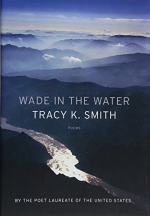|
This section contains 852 words (approx. 3 pages at 400 words per page) |

|
Wade in the Water: Poems Summary & Study Guide Description
Wade in the Water: Poems Summary & Study Guide includes comprehensive information and analysis to help you understand the book. This study guide contains the following sections:
This detailed literature summary also contains Quotes and a Free Quiz on Wade in the Water: Poems by Smith, Tracy K..
The following version of this book was used to create this study guide: Smith, Tracy K. Wade in the Water. Minneapolis, Graywolf Press, 2018. Hardcover.
In the opening poems, everyday scenes become divine: in “Garden of Eden,” it is remembered fruit; in “The Angels,” it is caring bikers or striking weather. In “Hill Country,” God looks over a canyon and tries to imagine “something larger than himself” at work (9).
The following poems take on a more global perspective. “Deadly” envisions the Christian moment of creation with humanity’s future destructiveness in mind. “A Man’s World” imagines an encounter with a man who dangles the world on a chain; “The World Is Your Beautiful Younger Sister” uses a rich man’s callous destruction of a young woman as a metaphor for capitalist use of the Earth. The people in “Realm of Shades” face a violent and uncaring world, while the strangers in “Driving to Ottawa” share a moment of connection despite their private despair.
The first section closes with “Wade in the Water,” in which a performer says “I love you” to all the strangers attending (15). In the song and dance, there is the memory of chains and labor, but now there is freedom, connection, and love.
The second section focuses on found and erasure poetry. “Declaration” takes the Declaration of Independence and removes words so that the text speaks in the voices of the slaves the original document abandons. “The Greatest Personal Privation” and “Unwritten” are adapted from the letters of nineteenth-century slave owner Mary Jones. Though the original letters support slavery, in the first poem Mary’s slaves react to the news of their upcoming sale, and in the second Mary pleads with her husband to release their slaves and “answer / For all that has happened” (23).
The centerpiece of the collection is the long poem “I Will Tell You the Truth about This, I will Tell You All about It,” which again uses the erasure technique, this time on the letters and documents of Black soldiers in the Civil War and their families. The poems often preserve the original spellings to show the daily lives, personal struggles, and moving relationships of these forgotten historical figures. Interludes in italics combine many documents to create pleas for justice from soldiers who have not experienced the freedom and prosperity they had been promised. The final section focuses on the soldiers’ names and the many barriers they faced in accessing justice and state support. Part Two closes with the poem “Ghazal,” which laments the historical and current traumas that have impacted “our name.”
The Third section opens with “The United States Welcomes You,” which interrogates arriving people with a paranoid and hostile tone. In “New Road Station,” the speaker searches with difficulty for an image to personify the rush of history. “Theatrical Improvisation” uses scripts and stage directions to describe an endless series of attacks, with actors portraying both victims and perpetrators for the audience. “Unrest in Baton Rouge” imagines a love that could cut through scenes of police violence and provide a universal language.
The found poem “Watershed” intercuts free-verse poetry based on a newspaper article about the waste from a DuPont factory with prose poetry accounts of near-death experiences. While the DuPont sections investigate the pollution, human suffering, and global environmental catastrophe that capitalist greed has caused, the prose poems offer images of clarity, universal connection, and love.
“Political Poem” closes the section with an image of two mowers working a field, acknowledging each other from afar in an endless “instant of common understanding” (55)
“Eternity” opens Part Four with a five-section poem set in Beijing, China. In each vignette, the speaker experiences a different scene in the city while philosophizing about family, youth, and time. “Ash” describes a “strange house” that eats and feels desire, guilt, and pride.
“Beatific” and “Charity” show small moments in the lives of strangers. In the first, the speaker watches a man dance across an intersection, to the annoyance of the watching drivers. In the second, the speaker sees an old woman climbing a steep sidewalk, identifying with that determination.
“In Your Condition,” “4½,” and “Dusk” trace the speaker’s relationship with her daughter from pregnancy to growing independence. “Urban Youth” is a pantoum describing memories of the speaker’s childhood and siblings in the 1970s. “The Everlasting Self” describes a dog coming inside from the rain and shaking water off, which the house absorbs like “love / From a lifetime ago” (71). In “Annunciation,” the speaker expresses shame at the ease and comfort of modern life. They long for “something large and strange and cruel” (72).
The closing poems return to the theme of love. In “Refuge,” the speaker chooses to see in refugees the qualities and struggles they admire and love in their own mother, daughter, and father, until they can understand the refugees in their own right. “An Old Story” describes a storm of hate and want that overtakes everything. After it passes, however, the people can take stock of the destruction and look to each other and nature for “a different manner of weather” (75).
Read more from the Study Guide
|
This section contains 852 words (approx. 3 pages at 400 words per page) |

|



